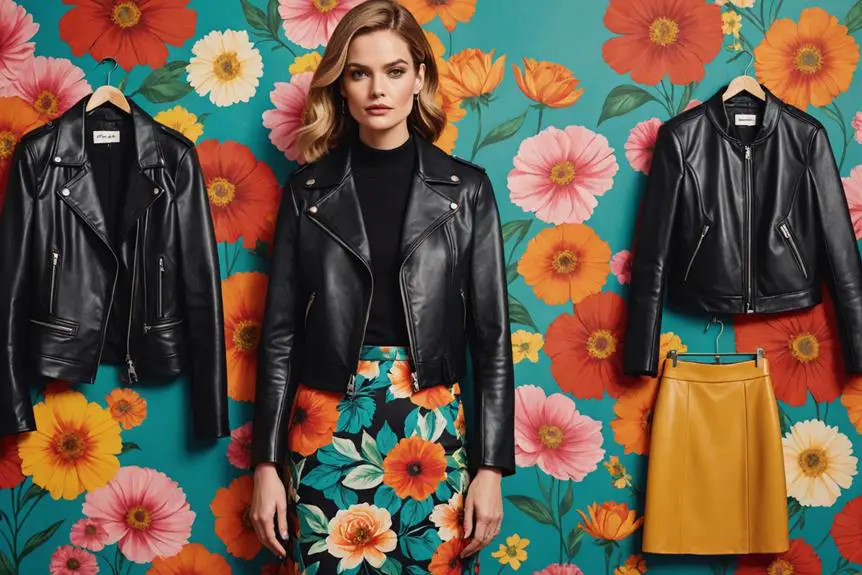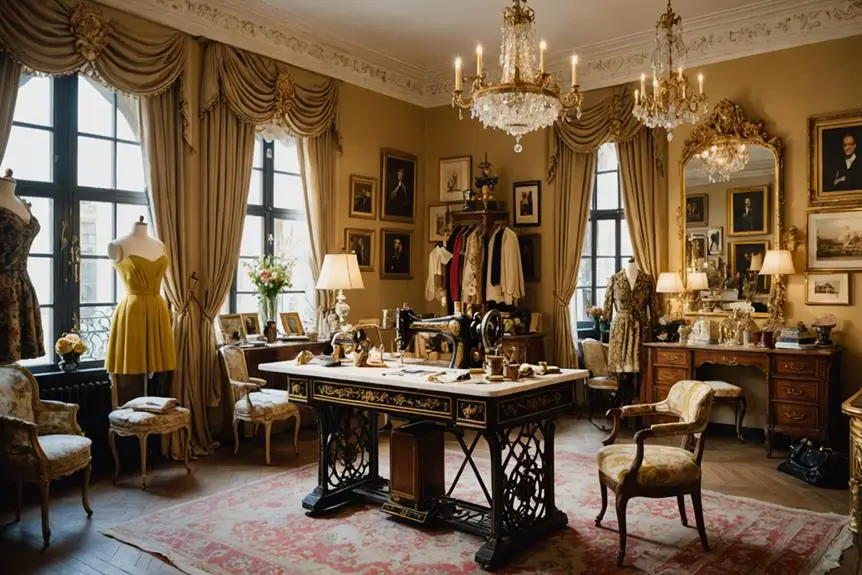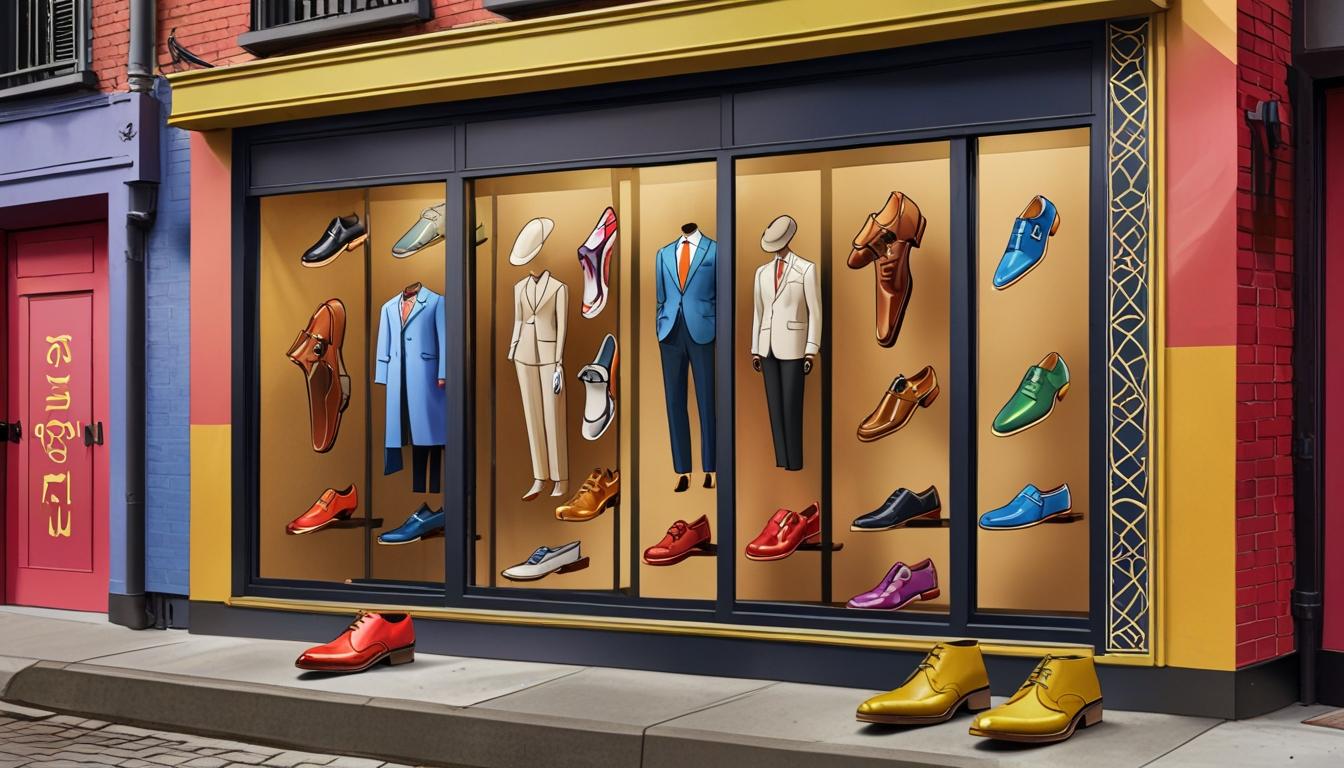When you think about Hollywood TV show outfits, it's clear they do more than just adorn the characters. You'll notice how these carefully crafted looks reflect deeper narratives and personal journeys, often intertwined with historical influences like the 1940s. Costume designers collaborate with creators to bring authenticity to the screen, using fabrics and styles that evoke both nostalgia and modernity. As you consider the impact of these outfits, it raises a question: how do these fashion choices resonate with viewers and shape cultural trends today?
Costume Design Collaboration
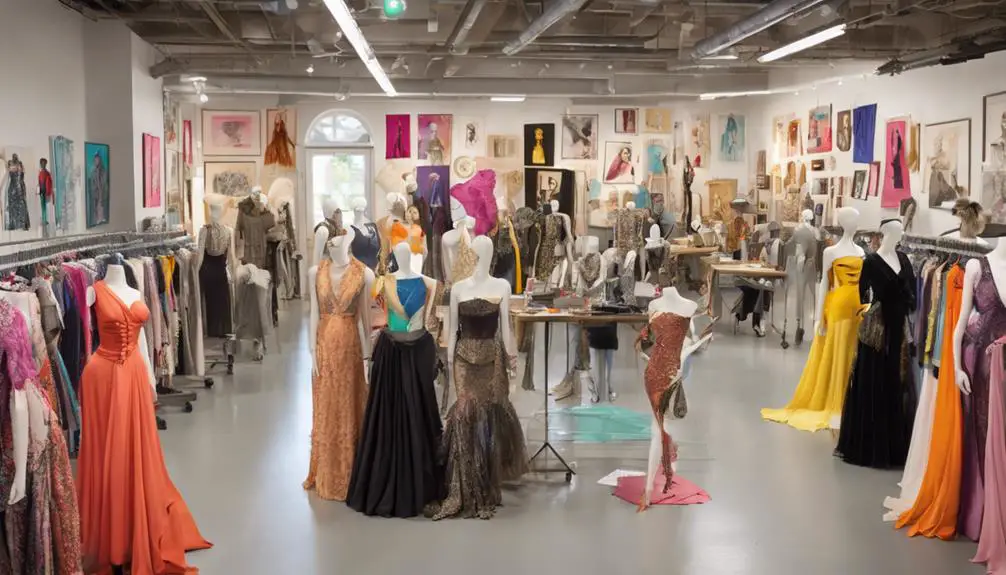
When it comes to costume design in *Hollywood*, collaboration is key. The talented duo of Lou Eyrich and Sarah Evelyn teamed up with the visionary Ryan Murphy to create an authentic aesthetic that captured the glamour of the 1940s. Their process was far from simple; it required extensive research into classic films and historical fashion, ensuring that every costume felt both vintage and relevant to modern viewers.
Their commitment to authenticity can be likened to the dedication seen in vintage fashion, where identifying elements like Chanel logo and tag identification is essential for ensuring true representation.
By collaborating with a fashion historian, they gained access to rare images and insights, which greatly enhanced their accuracy in costume choices and character representations. This meticulous attention to detail didn't just stop at costumes; it extended to hair and makeup, with the design team working closely alongside these departments to create cohesive looks that aligned with the show's narrative and character development.
Lou and Sarah valued creativity and fun in their collaboration, leading to memorable costumes that resonated deeply with actors and audiences alike. Every piece they crafted reinforced the show's themes and emotional tones, showcasing how collaboration can elevate a project to new heights.
In this vibrant landscape of *Hollywood* fashion, the synergy between Lou, Sarah, and Ryan is a demonstration to the power of teamwork. Their combined efforts haven't only brought the past to life but have also inspired a new appreciation for vintage aesthetics in modern storytelling.
Iconic Character Wardrobes
When you think of iconic character wardrobes, you can't help but appreciate how timeless glamour influences every choice.
From Laura Harrier's luxurious dresses to Samara Weaving's vibrant silhouettes, each outfit reflects the character's journey while nodding to vintage inspirations that shimmer with significance.
These fashion choices not only enhance the storyline but also transport you to an era where style was as essential as substance, making each character unforgettable.
Timeless Glamour Inspirations
Timeless glamour in Hollywood TV shows often comes alive through the wardrobes of iconic characters, whisking viewers back to an era of sophistication and style.
Take Laura Harrier's character, Camille, for instance. Her luxurious furry stoles and glamorous dresses evoke the classic elegance of 1940s Hollywood icons like Katharine Hepburn and Lauren Bacall, showcasing how vintage pieces can embody timeless style.
Similarly, Samara Weaving's Claire draws inspiration from legendary bombshells such as Marilyn Monroe and Veronica Lake, flaunting tailored silhouettes and vibrant color palettes that reflect her emotional journey.
Meanwhile, David Corenswet's Jack honors the golden age of Hollywood with a vintage fedora from his grandfather, merging personal history with the era's chic aesthetics, reminiscent of classic male stars like Cary Grant.
Patti LuPone's Avis Amberg pays homage to Joan Crawford and Barbara Stanwyck, sporting bold leopard-print jackets and jewel-studded power suits that signify authority and glamour.
Finally, Dylan McDermott's Ernie West reflects the refined style of Fred Astaire, donning crisp, tailored suits with vintage ties that enhance his character's sophisticated persona.
Each outfit not only tells a story but also celebrates the enduring allure of Hollywood glamour.
Character-Driven Fashion Choices
Often, iconic character wardrobes in Hollywood TV shows reflect their personalities and journeys, transforming fashion into a storytelling medium.
Take Laura Harrier's character Camille, for instance; her glamorous 1940s fashion, complete with furry stoles and vibrant dresses, signifies her status as an era icon. Similarly, Samara Weaving's Claire evolves from fitted silhouettes to softer styles, mirroring her emotional journey and drawing inspiration from Hollywood legends like Veronica Lake and Marilyn Monroe.
Patti LuPone's Avis Amberg channels the boldness of Joan Crawford and Barbara Stanwyck with leopard-print jackets and jewel-studded power suits, showcasing how clothing can express strength.
Holland Taylor's Ellen, sporting tailored skirt suits and pants inspired by Hedy Lamarr, embodies character authority in a male-dominated industry, proving that fashion can be empowering.
Dylan McDermott's Ernie West wears crisp all-white uniforms, a nod to authority, while David Corenswet's Jack adds a personal touch with a vintage fedora from his grandfather.
Each of these fashion choices reflects not just style, but a deeper connection to the characters' identities and arcs, demonstrating that in the world of Hollywood, wardrobe choices tell powerful stories.
Vintage Material Significance
Vintage materials play an essential role in shaping the iconic wardrobes of characters in Hollywood TV shows. By utilizing 75%-80% vintage fabrics in the costume design for the series "Hollywood," designers like Sarah Evelyn and Lou Eyrich achieved remarkable period authenticity. This creative collaboration not only paid homage to 1940s Hollywood fashion but also highlighted how vintage-inspired materials can enhance character wardrobes while accommodating modern body shapes.
Custom-designed pieces, such as Claire's embroidered crop-top sets and tailored skirt suits for Ellen, exemplify this approach, blending nostalgic visual aesthetics with contemporary flair. Each character's wardrobe is a reflection of their unique traits, showcased through specific fashion choices—think Camille's warm butterscotch hues or Claire's chic tapered silhouettes.
The meticulous attention to sourcing vintage items contributes considerably to the show's allure, inviting viewers to immerse themselves in a glamorous past. By emphasizing the importance of vintage materials, these costume designers craft visually stunning garments that resonate emotionally, ensuring that audiences not only see but feel the magic of classic Hollywood.
Whether you're a fashion enthusiast or a casual viewer, the significance of these vintage materials is undeniable, creating a timeless connection that enriches storytelling.
Inspirations Behind the Styles
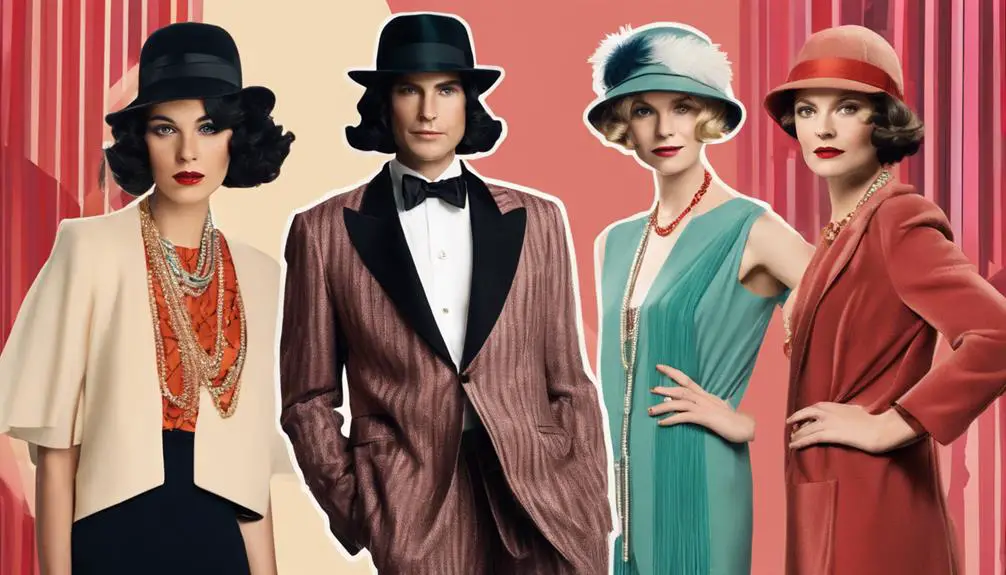
The stunning costumes in *Hollywood* showcase a rich tapestry of influences drawn from iconic films of the 1940s, capturing the glamour that defined the era. Costume designers Sarah Evelyn and Lou Eyrich partnered with fashion historian Raissa Bretaña to achieve a level of authenticity that resonates with both history and modern sensibilities.
You'll notice how they incorporated vintage materials, breathing new life into classic styles while ensuring the pieces fit the modern body.
One standout element is the distinctive color palette, often referred to as "harvest tones." This vibrant array of colors enhances the visual storytelling, reflecting the emotional journeys of the characters. For instance, Camille's pink ball gown pays homage to Hattie McDaniel's Oscar gown, symbolizing the bittersweet essence of lost opportunities in Hollywood.
Such careful attention to detail reveals how costume designers crafted the clothing not just as outfits but as extensions of character traits and power dynamics.
The glamorous aesthetics of 1940s icons like Veronica Lake and Marilyn Monroe shine through tailored suits and luxurious dresses, reminding you of an era where style spoke volumes.
Every stitch, every fabric choice, contributes to a narrative that celebrates both the beauty and complexity of Hollywood's history. As you watch, you can appreciate how the costumes not only evoke nostalgia but also connect you to the characters' struggles and triumphs, making the series not just a visual feast, but a heartfelt tribute to a golden age of cinema.
Memorable Costume Moments
Costume moments in *Hollywood* leave a lasting impression, showcasing the creativity and artistry behind each outfit. One standout is the service-station uniform, which has been hailed as the most memorable costume in the series. This uniform exemplifies meticulous fabric selection and personalized tie chain initials, elevating a simple outfit into a statement of style and character.
Vintage fashion elements play a significant role in capturing the essence of the 1940s, reminiscent of how identifying vintage Ralph Lauren items requires attention to details like tags and logos. Laura Harrier's character, Camille, shines with her glamorous wardrobe that features furry stoles, elegant dresses, and signature red lip looks, all embodying the essence of 1940s luxury. Each piece is carefully curated to reflect not just fashion but a lifestyle of sophistication.
Patti LuPone's Avis Amberg takes a bold approach with her leopard-print jackets and jewel-studded power suits, drawing inspiration from iconic actresses like Joan Crawford and Barbara Stanwyck, making her a memorable figure in the series.
The final episode brings everything together, prominently featuring significant integration of vintage items, which reinforces the show's commitment to authentic 1940s fashion. This level of commitment is also evident in the custom-designed lingerie, showcasing incredible historical accuracy and the attention to detail that permeates every aspect of the costume design process.
These memorable costume moments not only tell a story but also transport you back in time, allowing you to appreciate the artistry behind each outfit and the way they enhance character development. Whether it's a simple uniform or a luxurious gown, each piece resonates with the audience, creating an unforgettable visual experience.
1940s Fashion Influence

As you explore the fashion influence of the 1940s in *Hollywood*, you'll notice the challenges costume designers faced in balancing authenticity with modern aesthetics.
They drew inspiration from iconic styles of the era, integrating key elements like tailored silhouettes and vibrant harvest tones, which not only reflect the glamour of Old Hollywood but also resonate with today's viewers.
This thoughtful approach guarantees that while the characters pay homage to the past, they also embrace a fresh, contemporary vibe that captivates audiences.
Costume Authenticity Challenges
Authenticity in costume design often grapples with the complexities of historical representation and modern practicality. When it comes to creating costumes for *Hollywood*, designers faced significant authenticity challenges, particularly in sourcing genuine 1940s clothing. Scarcity and sizing issues prompted the shift toward made-to-order costumes that cater to modern body shapes, ensuring that everyone can feel great in their outfits.
Extensive research into classic films, along with collaboration with a fashion historian, helped the team reflect the historical context while appealing to today's audience. They drew inspiration from iconic figures like Hattie McDaniel and films such as *Casablanca*, capturing the essence of the era without rigidly sticking to historical accuracy.
While women's costumes largely embraced the 1940s style, men's suits underwent adjustments to fit contemporary silhouettes. The designers employed a distinct color palette and textures that honored original designs, allowing for creative interpretation.
This balance of authenticity and modern appeal not only pays homage to the past but also makes the costumes relatable and enjoyable for viewers today. Ultimately, this thoughtful approach showcases the artistry and dedication behind costume design, bringing the glamour of the 1940s to life once more.
Iconic Style Inspirations
The iconic style of the 1940s continues to influence fashion today, thanks to legendary stars like Joan Crawford, Barbara Stanwyck, and Marilyn Monroe. In the series *Hollywood*, costume designers Evelyn and Lou Eyrich pay tribute to these 1940s film stars by creating custom-designed costumes that capture the glamour and sophistication of the era.
You'll notice how Claire's vibrant palette not only reflects her character's evolution but also embodies the essence of a Hollywood siren.
The show showcases tailored suits and glamorous dresses, featuring big shoulders and menswear-inspired pieces that are hallmarks of the Golden Age of Hollywood. These elements enhance the authenticity of the period, making you feel as if you've stepped back in time.
Each detail, from fabric choices to silhouette, is meticulously crafted to resonate with modern fashion trends, proving that the influence of the 1940s remains ever-present.
Cultural Significance of Costumes
Costumes in *Hollywood* aren't just eye-catching outfits; they serve as powerful storytelling tools that reveal character depth and cultural tensions of the 1940s. The costumes reflect pivotal themes of representation and diversity, showcasing how the film industry has evolved. Designers like Lou Eyrich and Sarah Evelyn meticulously crafted wardrobes that evoke nostalgia, drawing inspiration from iconic figures such as Hattie McDaniel and Anna May Wong. This approach enhances historical accuracy while making these costumes relatable to modern audiences.
By incorporating elements of vintage clothing identification, the designers guarantee that the outfits resonate with authenticity and depth. By utilizing vintage materials paired with contemporary silhouettes, they bridge the gap between the past and present, making certain the fashion feels relevant today.
The series cleverly critiques Hollywood's historical treatment of marginalized groups through its costume choices, employing vibrant color palettes that signify character evolution and emotional states. This visual language serves as a cultural commentary on the aspirations and challenges faced by Hollywood figures—both fictional and real—during a transformative period.
Each outfit isn't merely an accessory; it's a reflection of the societal norms and cultural conflicts of the era, making it an essential part of the narrative. Costumes act as a lens through which you can understand the trials and triumphs of the characters, enriching your viewing experience.
As you immerse yourself in the world of *Hollywood*, you'll find that these costumes aren't just about aesthetics; they represent a dynamic tapestry of history, identity, and the relentless pursuit of authenticity in storytelling.
Evolution of Glamour in Hollywood
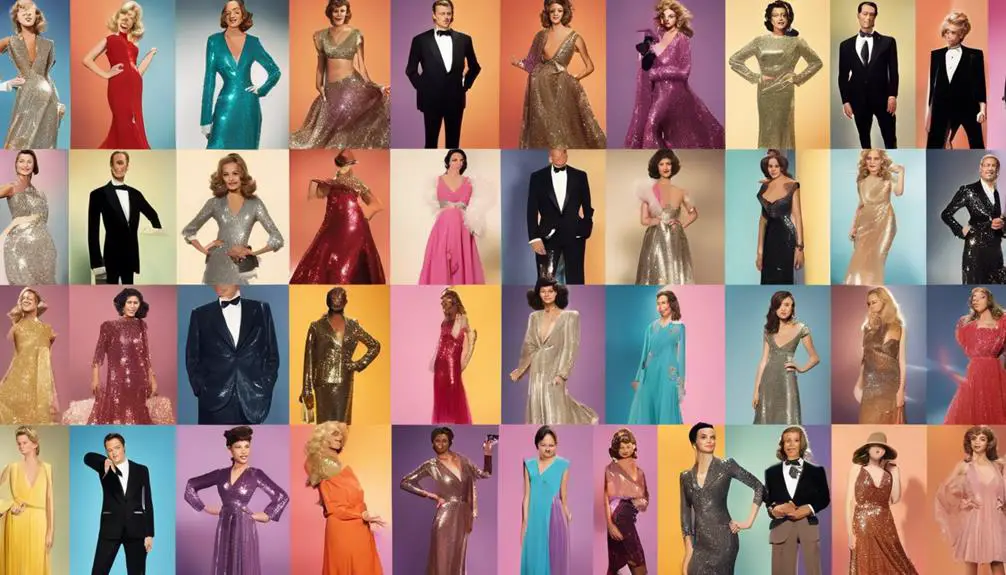
Glamour in Hollywood has undergone a remarkable transformation, shifting from the rigid silhouettes of the 1940s to a vibrant tapestry of styles that celebrate individuality. Back in the 1940s, fashion was marked by structured lines, tailored suits, and satin gowns. This era defined glamour with marabou feathers and a strict aesthetic that spoke to a different time.
However, today's landscape is a melting pot of contemporary trends that embrace personal expression and risk-taking. Ryan Murphy's *Hollywood* beautifully captures this evolution, showcasing the nostalgia of vintage styles while integrating modern elements. You'll notice how designers like Dolce & Gabbana and Gucci have resurrected the essence of 1940s fashion, blending it with current tastes to create stunning red carpet looks.
This revival indicates that the elegance and allure of the Golden Age continue to inspire, offering escapism during challenging times. Moreover, the evolution of glamour reflects broader societal changes, moving away from strict gender norms to a more inclusive approach.
Today's fashion allows for diverse expressions, showcasing that glamour isn't just about looking good; it's about feeling empowered and confident in your skin. As styles evolve, you'll find that Hollywood remains a beacon of creativity, where personal expression reigns supreme.
